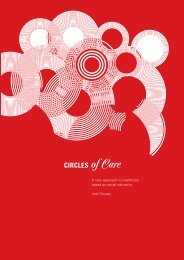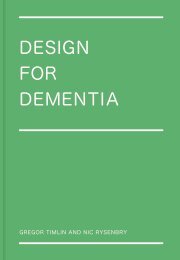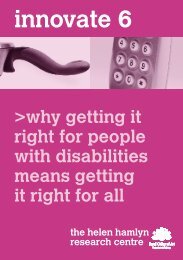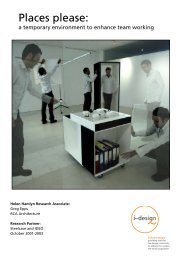Design for Dementia - Helen Hamlyn Centre - Royal College of Art
Design for Dementia - Helen Hamlyn Centre - Royal College of Art
Design for Dementia - Helen Hamlyn Centre - Royal College of Art
You also want an ePaper? Increase the reach of your titles
YUMPU automatically turns print PDFs into web optimized ePapers that Google loves.
DESIGN FOR DEMENTIA<br />
BEDROOM<br />
DRESSING<br />
Dressing is an intensely private experience.<br />
As dementia progresses, a person’s cognitive<br />
and physical abilities decline to the point at<br />
which they must accept assistance <strong>for</strong> others,<br />
dress in the presence <strong>of</strong> another person, or<br />
even have a carer dress them. This process<br />
can be stressful and frustrating. Numerous<br />
care strategies have been developed to<br />
help people adjust to the new realities <strong>of</strong><br />
assistance with dressing. But relatively little<br />
attention has been given to the design <strong>of</strong> the<br />
environment or products that a carer uses to<br />
per<strong>for</strong>m this assistance, resulting in a make<br />
do approach by both carers and residents.<br />
Wellbeing and self-esteem are linked to<br />
personal appearance. In short, looking good<br />
can help you feel good and retaining one’s<br />
identity through appearance can be a positive<br />
experience <strong>for</strong> a resident as well as portraying<br />
a positive image to others. Dressing is a<br />
fundamental activity <strong>of</strong> daily living and the<br />
gradual loss <strong>of</strong> this ability by care residents<br />
can be very stressful and frightening.<br />
Enabling Interventions<br />
–<br />
Many person-centred care strategies have<br />
been developed so carers and family can<br />
assist a person only when necessary and<br />
in such a manner that helps alleviate any<br />
frustrations and fears. The majority <strong>of</strong> these<br />
strategies are based around a resident having<br />
choice and making decisions – although<br />
choice is usually limited – and by making a<br />
remote assessment <strong>of</strong> abilities so as not to<br />
over-assist.<br />
Inappropriately designed and specified<br />
furniture can lead to a person requiring<br />
unnecessary assistance in situations where<br />
better support mechanisms could extend<br />
independence. The aim should be to maximise<br />
a resident’s abilities so the requirement <strong>for</strong><br />
external support is kept to a minimum. Take<br />
<strong>for</strong> example, access to low drawers. One<br />
person interviewed with early stage dementia<br />
was unable to reach or bend over to the lower<br />
drawers in his bedroom cabinet. It took<br />
him time and patience to open the drawers<br />
by hooking his walking stick through but<br />
eventually he was able to do so. For a person<br />
with similar physical capabilities but more<br />
advanced dementia, this would not be possible.<br />
Conceptually it would be too difficult<br />
a process to connect the walking stick with<br />
opening a drawer.<br />
Simple enabling interventions, as seen<br />
in one care facility, held some surprising<br />
results. Residents were actively involved in<br />
the dressing cycle, a strategy that proved<br />
beneficial by giving them purpose. Washing<br />
baskets were introduced into their rooms<br />
and some took pride in being part <strong>of</strong> a daily<br />
routine and assuming responsibility <strong>for</strong><br />
their lives. Some people with dementia are<br />
incontinent, feel ashamed and hide the dirty<br />
sheets and clothing rather than face up to the<br />
embarrassment. The provision <strong>of</strong> a washing<br />
basket meant that they could put their sheets<br />
and clothes into the basket themselves<br />
without embarrassment.<br />
Staff in this care facility would collect<br />
the washing and, where necessary, collect<br />
any clothes that needed washing that weren’t<br />
in the basket. Assistance with dressing<br />
was trans<strong>for</strong>med into a positive activity <strong>for</strong><br />
residents, contributing to their self-image<br />
and sense <strong>of</strong> purpose.<br />
Guided by research into dementia, much<br />
current furniture <strong>for</strong> dementia care has been<br />
designed within certain aesthetic guidelines<br />
that aim to prompt a person’s memories and<br />
help care residents remember what an object<br />
is and what it does. The use <strong>of</strong> aesthetics to<br />
help recollect functions is a valuable tool, but<br />
it can also be very limiting.<br />
Where designers and manufacturers<br />
attempt to combine new dementia-friendly<br />
features into older-style furniture, both<br />
innovations in usability and the aesthetics<br />
<strong>of</strong> reminiscence can be compromised. Styles<br />
change, so it is important that innovations<br />
and aesthetics are mutually supportive in<br />
An existing bedroom interior<br />
81

















